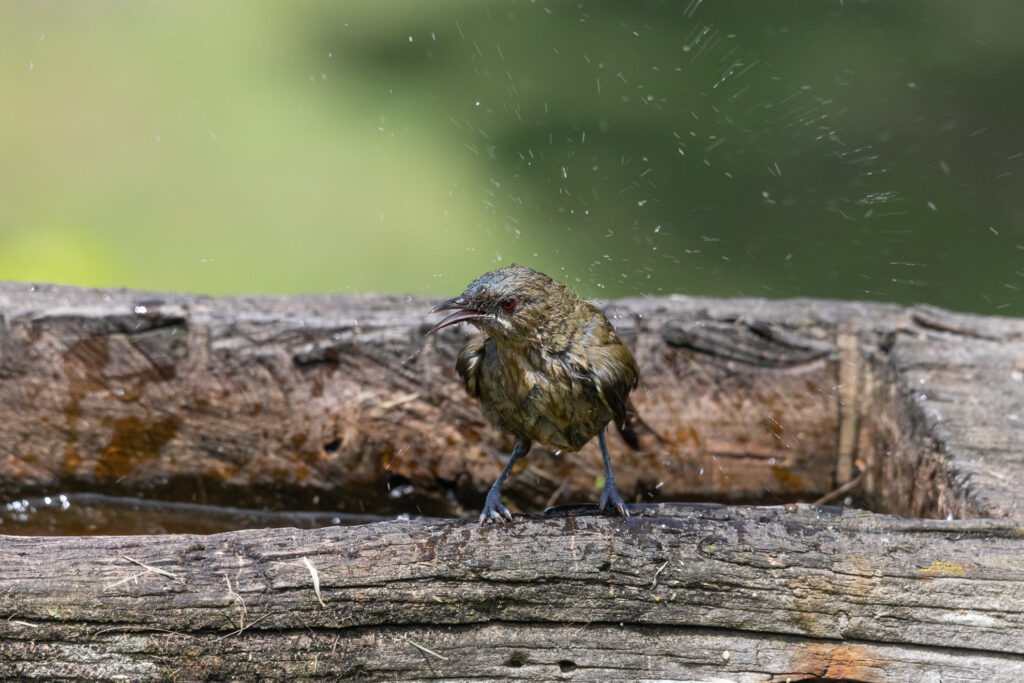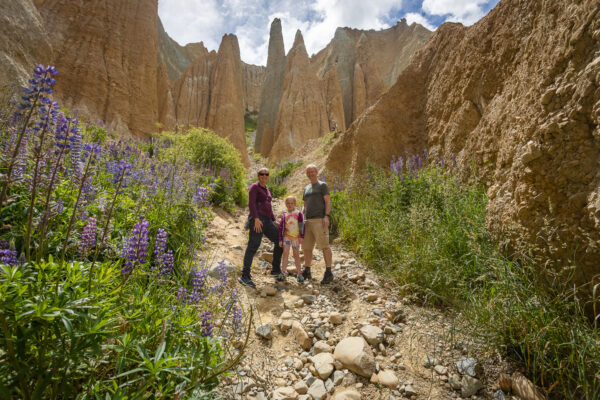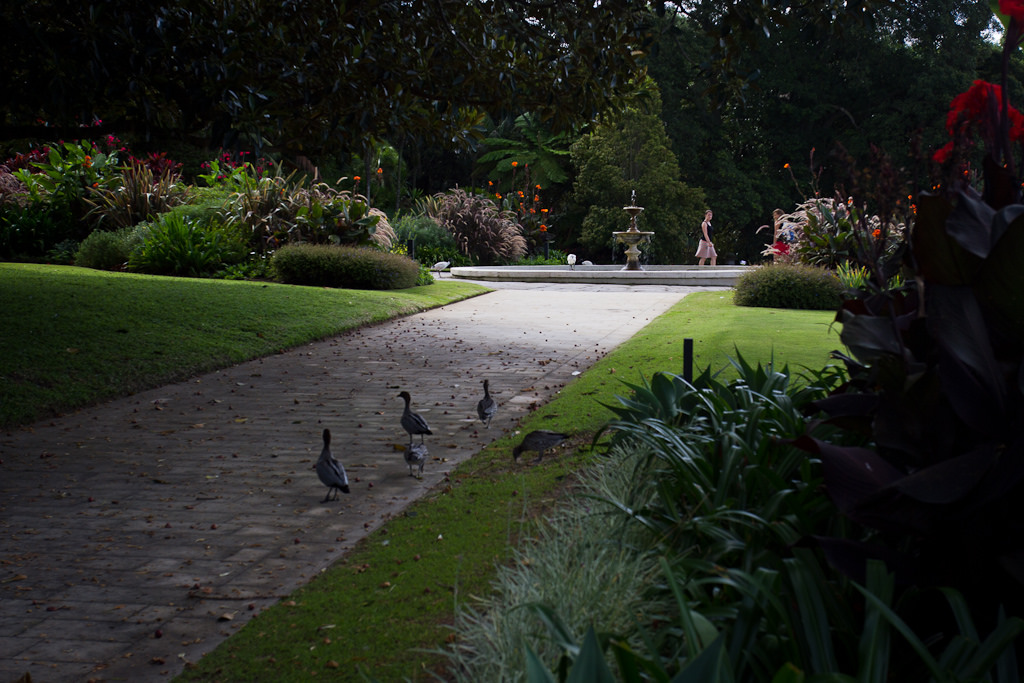Late last year (2020) I entered a Wellington region photo competition and won a prize of an overnight glamping trip to Kapiti Island. We finally took the trip last weekend, though it almost got delayed due to the weather the previous week. The south end of the North Island has had a prodigious amount of rain during December and tracks on the eastern side of Kapiti Island at Rangatira Point were closed due to slips. A normal overnight stay with Kapiti Island Nature Tours involves travelling first to Rangatira and then transferring to the northern end for the overnight portion, we wouldn’t be able to do this. A compromise was offered and we instead would be staying at the north end of both days. Friends had Alayna for the weekend (thanks Kelly and Drew!) so we were all set.
We checked in at the Kapiti Island Nature Tours office in Paraparaumu and went through the standard bag checks required for entering a nature sanctuary. With no hidden pests discovered we moved on down to the boat club to park and make final preparations. The boat was departing from the beach so we took ourselves down to wait (after first trying to board the wrong boat from the other Kapiti Island tour company). Modified tractors with elongated frames are used to launch and collect the boats, it was a blustery morning so the swell was messy and the water was still brown after all the recent rain. Thankfully it’s only a short 15 minutes from the beach to the island. We chatted to a staff member who was waiting for the boat and I took some photos of a group of oystercatchers that were chilling out next to the stream that emptied into the ocean.



The boat ride was bumpy with a fair bit of roll as we crossed the swell at an angle to get to the island, but short enough that no-one was ill. We disembarked onto a rocky shoreline where a number of people waited, along with a quad bike with attached trailer. We were welcomed by Manaaki Barrett and he was a constant presence over our two day stay. Manaaki’s parents and Aunty set up Kapiti Island Nature Tours over 20 years ago now and Manaaki joined the family business as nearly 10 years ago now. Manaaki explained how everything would be working and then took our group off for an introduction to the islands history, which includes a lot of his own family history as his whanau have been living on Kapiti Island for more than 200 years. You can read about that history, and a lot more, in the following articles:
Stuff: Utauta’s stand: How one family held their island home for 200 years
This is NZ life: Meet the Barrett whanau the guardians of bird-lover’s paradise Kapiti island and Kapiti Island Nature Tours lodge
With Rangatira unavailable there were many more visitors at the North end, so we had to wait for another group to depart the visitor shelter where Manaaki would show us the tracks available on the island. In the meantime we were introduced to the islands wildlife via some beautiful photos (which he took, you can see his photos here: https://manaaki.pictures/) and some obliging live specimens. We saw kakariki (red crowned parakeets) chittering and flying around, p?pokotea (whiteheads) chatting away in the bush, plentiful tui and the occasional korimako (bellbird) making the most of the nectar available from the flowering harakeke (flax). A tieke (North Island saddleback) decided to make an appearance as well, calling from nearby bush and then helpfully flying past the group. Once we were able to visitor shelter Manaaki showed us the tracks on a big map. Due to nesting activity the boulder loop which circled Okupe Lagoon was closed on the coastal side but we still had the 4km Okupe Valley loop available, and there was plenty of walking available near our accommodation and visitor lodge. Some of the group had a guided tour coming up with Manaaki leading and the rest of us were free to choose our own path. Before the group split up we all spent some time peering at the roof beams looking for geckos that teased by showing their head or tail before squirrelling away to hide better under the warm roofing iron. We were all also tasked with keeping an eye out for the resident takahe that had recently hatched a chick, but the chick hadn’t been seen for a few days.



It was a warm day with bright blue skies so we took a leisurely pace as we walked the Okupe Valley loop. We saw our first weka and kaka, also mistaking the raucous calling of weka through the valley for kiwi calling (we did wonder why kiwi would be calling during the day). We also heard koekoe? (long-tailed cuckoo) and I’m pretty sure I saw one flying above the valley, its long tail bobbing as it flew, and in the forest there were lots of friendly toutouwai (North Island robin) near and on the track. Lunch was at the lookout at the top of the valley where a cheeky weka was inspecting everyone and their bags for opportunities to steal food. There was a cool breeze at the cliff edge which was great after the upward climb in the heat of the day.
After lunch we completed the loop and made our way back past our island arrival point and on to the lodge. This was a meeting point for all those staying on the island and was where we again saw Manaaki. We were shown around the lodge where there was fruit and biscuits available along with water, juice and tea/coffee. Toilets and showers were also available. Then we were led to our glamping tent and left to our own devices until dinnertime. The tent was a large canvas affair with a comfy double bed inside. Nearby was our own private composting toilet, very convenient. We relaxed for a while and simply watching from the tent saw or heard most of the birds we had seen while walking. We were also amused to find a moko mangaeka (gold-stripe gecko) checking us out and then walking onto our deck. It then inspected the gaps between the decking boards until it found one it could squeeze down into and hide. Later on a bold weka was on the deck and then wandering into the tent like it owned the place, I guess it had more right to it than us.


Before it was time for pre-dinner drinks and nibbles we went for another walk along the beach. This walk was curtailed once we realised that there were increasing numbers of karoro (black-backed gulls) raising grey fluffy chicks along the shoreline, so we instead walked back through the low bush on the way back towards the Okupe lagoon and valley. The takahe were still hiding from us but we did briefly spot a young weka, its parents calling it urgently to hide.



It was a beautiful early evening as we settled down at the Lodge for drinks and nibbles. We were warned about the kaka that would try and take any unguarded food, and true to form a kaka appeared once the cheese, dips and crackers came out. There were a couple of water guns on the outside table for deterrence, the kaka didn’t seem to bothered by the implied threat. It wasn’t until a few people had left the table that the kaka tried its luck, Keryn was quicker to the platter but undeterred the kaka landed instead on her back in its attempt to snatch a snack. I shooed it away, unfortunately too quick for a fellow guest who was about to take a photo of Keryn and her kaka passenger.
Dinner was served inside, soup to start followed by a buffet of roast beef with a potato bake, a vegetarian eggplant dish and three yummy looking salads. All the food we had (dinner, breakfast and lunch the next day) was wonderfully cooked and tasty, the chef outdoing himself. With pleasant company and a lovely meal dinner was great, and followed by desert to top everything off.
There was more time to relax after dinner before we all came back to the Lodge around 9:30pm to go looking for kiwi. By now it was still with a near full moon rising over the mainland and lighting up the night. We split into groups and were led by red torchlight through forest paths looking for kiwi pukupuku (little spotted kiwi). In the distance we could hear ruru and kiwi pukupuku calling along with the occasional loud squawks of weka, but unfortunately we were not able to see any kiwi ourselves. We did see a gecko that Manaaki plucked off the forest path and carefully let wander over his hand while we got a closer look. The takahe were also heard booming softly to each other in the undergrowth near the island compost patch. We had been told that kiwi had been seen in the bush beside our tent over the past couple of nights so we stayed up late just sitting on our deck and listening to the sounds of the forest, but no kiwi came to visit.
In the morning I went for a ramble before breakfast, the extremely loud dawn chorus started early and woke me up enough times that I decided I might as well so looking for birds if they were so keen to make their presence known. Kakariki were feeding in the grass not far from the tent, a young korimako cheeping in a nearby bush was regularly visited by its mother carrying food, bees were busy in the harakeke, ignoring the frequent tui visitors chasing each other around the popular spots. Kereru were also feasting on new-growth leaves, completely unconcerned by passing people.






We had breakfast in the Lodge, a variety of cereals and toppings with toast and scrambled eggs all available. Then we had the rest of the morning to ourselves again, only having to be back in time for lunch. We again walked to the lookout, this time it being not so hot and with even less people around. We heard and saw a karearea (NZ falcon) in the distance, soaring over the forested hills, and later on watched a kahu (harrier hawk) swooping low over the grassland near the lagoon before being chased off by vigilant poaka (pied stilt) who were no doubt protecting there chicks. It was a breezier day and back near the coast there were tui chasing each other around the pohutukawa. A large yellow-flowering pohutukawa near the lodge was nearly spent but a number of other trees along the coast were bursting with red blossoms.






Lunch was, as you might expect, wonderful and once replete we had a few hours left to wait before the boat would pick us up mid-afternoon. The highlight of the afternoon was watching birds bathing in the water bath created out of a hollowed out sleeper which was in front of the lodge. Tui came and went, usually chased away before they could wash. Then a cautious korimako popped out of the bush and spent a few minutes dipping in the water and then having a vigorous shake, repeating this over and over.

Soon enough it was time to head down to the beach and wait for our transport back to Paraparaumu. Manaaki drove our bags down and we followed to sit on the benches by the landing spot. The resident customs agent, an officious weka, inspected the bags for any loose straps and gaps that may contain food. The boat appeared on the horizon, ducked over to Rangatira Point and then sped over the waves to our beach. The wind was getting up and the waves were rolling out past the wind shadow provided by the island, so it was going to be another bumpy ride on our journey to the mainland. As the boat approached we could see one of the crew near the front, arms outstretched and mirroring her beaming smile, obviously enjoying the ride. The boat drove into the shore and the ramp came down, followed by disembarking passengers. Those on shore then took out turn to board after a farewell from Manaaki.
Kapiti Island treated us well, a slice of New Zealand as it could be and a refuge for a growing abundance of wildlife and regenerating forest. This won’t be our last visit to this special place.





